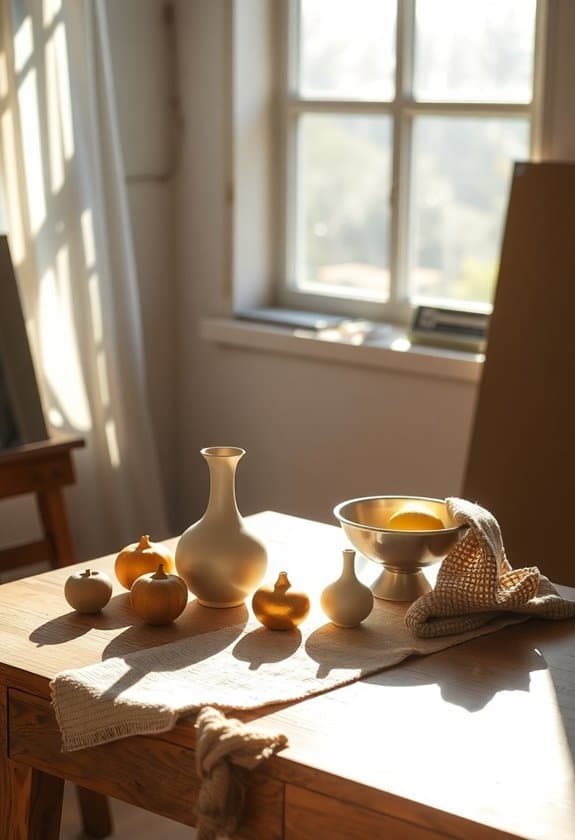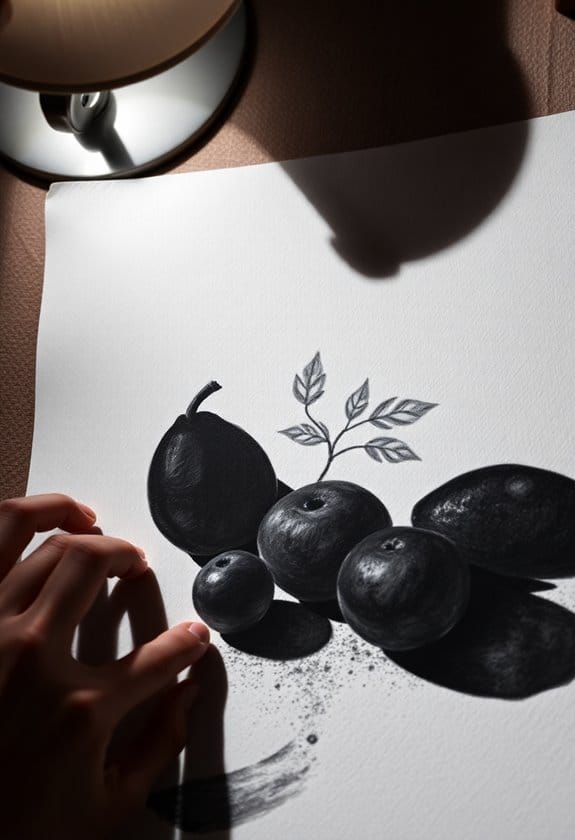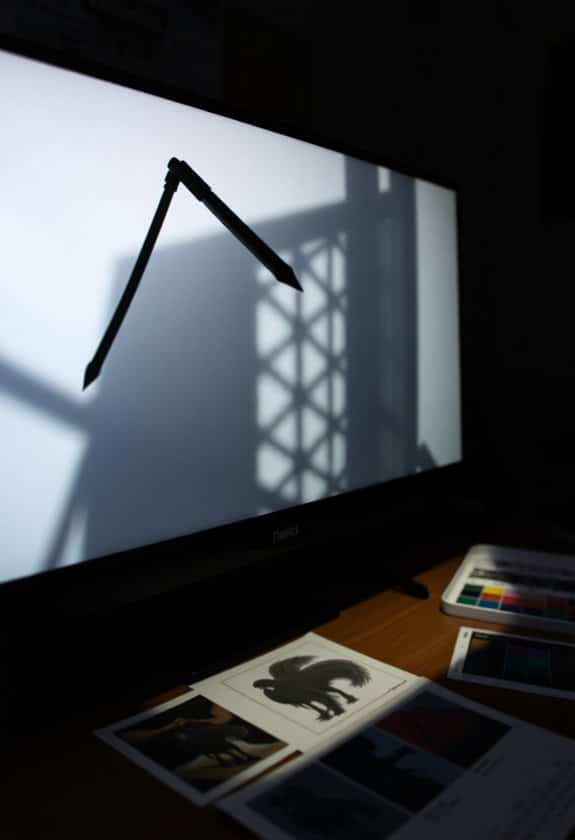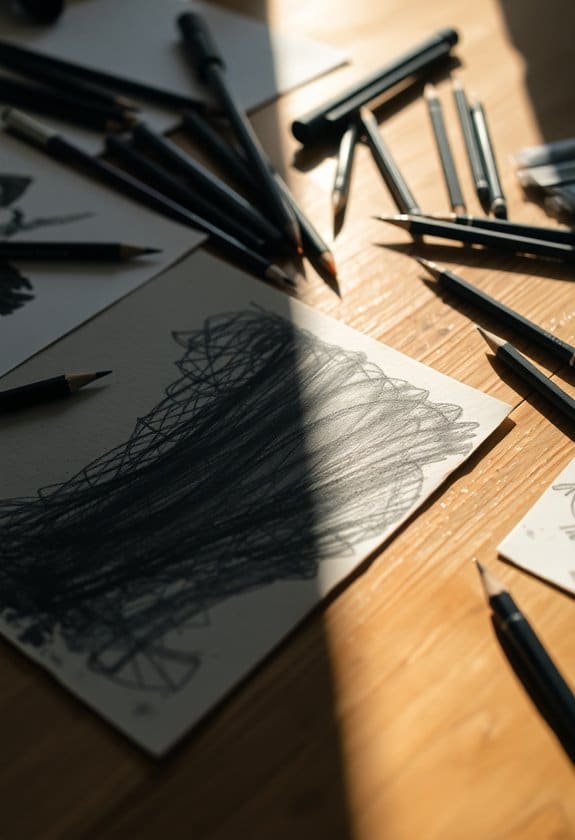Creating shadows effectively can make your art pop with depth and realism. Start by understanding your light source—it’s like the sun in your art world. With traditional media like charcoal, layer strokes to gradually build darkness, while watercolors offer soft shadow blends. Digital art simplifies this with layers and opacity sliders for natural looks. Pay attention to texture, mixing tones, and layering for more emotion and detail. Don’t forget to experiment; casting lamp shadows or observing nature can be enlightening, too! Just like practicing a cool skateboard trick, consistent experimentation perfects your shadows, revealing more artistic secrets.
Important Highlights
- Choose a clear light source to determine accurate shadow placement and direction.
- Practice layering strokes to gradually build up dark areas in traditional media.
- Use digital layers to adjust shadows without altering the entire artwork.
- Blend shadow edges softly for a more natural and realistic appearance.
- Observe and experiment with real-life shadows to enhance understanding and application.
Understanding Light and Shadow

Understanding light and shadow is essential for any artist aiming to bring depth and realism to their work.
Imagine a sunny day when the sun casts a shadow of your favorite tree on the ground. As an artist, you’ll capture that shadow, making sure it’s just the right size and shape.
You’ll need to reflect on where the light source is coming from and how it interacts with objects. This means noticing how light creates highlights and how shadows provide contrast. It’s like solving a fun puzzle!
Remember, the balance between light and shadow can make your artwork feel safe and inviting, just like a cozy room.
Practice often, and soon, you’ll find your own unique way of portraying them.
Techniques for Traditional Media

How can you effectively express your creativity using traditional media? Well, it’s all about using the right techniques to make your shadows pop.
Start with pencils or charcoal—they’re great for controlling shade intensity. Gently layer your strokes, gradually building up the dark areas. Be patient, and remember, a little goes a long way!
Watercolors can be trickier but offer beautiful results. Try mixing a bit more water for softer shadows. It’s like making shadow clouds on paper!
When using acrylics or oils, mix colors carefully to achieve the perfect shadow tone. Keep your brushstrokes smooth and blend edges for a natural shift.
Always work in a well-lit area to avoid eye strain. Safety first, so your creativity can shine bright!
Digital Shadow Creation

Creating digital shadows can transform your artwork, adding depth and realism with just a few clicks. Imagine crafting a shadow for a tree in your digital landscape; it’s like giving your art a heartbeat.
Start by selecting your light source—this guides where shadows fall. Use layers to separate shadows from other elements, ensuring you can tweak them safely without altering the entire image.
The opacity slider is your friend; adjust it to make shadows look natural, not like a monster lurking in the dark! I once struggled with a shadow that looked too harsh, and just by softening the edges, it suddenly felt right.
Mastering Tone and Texture

Just like digital shadows breathe life into your artwork, mastering tone and texture adds emotion and detail to your creations.
Imagine adding a soft, fluffy cloud to your scene—suddenly, your picture feels cozy, like a warm blanket on a rainy day. To give your art that safe, comfortable vibe, focus on blending colors smoothly. Use light and dark tones to show depth and create surfaces that feel touchable.
When I first tried this, my clouds looked more like lumpy potatoes! But with practice, you’ll find which tones work together best, just like matching socks.
Don’t rush; take your time to layer textures, whether it’s the rough bark of a tree or the sleek surface of water. Soon, your art will tell stories!
Advanced Shadow Techniques

Shadows aren’t merely the absence of light; they’re powerful tools that can transform your artwork into something mesmerizing. To master advanced shadow techniques, start by observing shadows in everyday life. Notice how they change during different times of the day.
For a safe approach, try using a simple lamp to cast shadows on objects—it’s a fun, risk-free way to experiment with light. When drawing, don’t just darken areas; vary the intensity to show depth and dimension.
Remember when I first tried this? I accidentally turned a cat into a blob! But practice makes perfect. Blend shadows softly with your pencils to avoid harsh lines.
Humor me—imagine shadows as your art’s secret agents, adding mystery without you even lifting a brush. You’ve got this!
Frequently Asked Questions
How Do Cultural Differences Affect the Perception of Shadow in Art?
You might be surprised how cultural differences shape the way people see shadows in art.
In some cultures, shadows might feel mysterious or even a bit spooky, while in others, they add depth and richness.
Think of it like how some folks find thunderstorms calming, while others might shiver!
It’s kind of like how your favorite snack might seem odd to someone else.
Shadows in art can feel different depending on where you’re from!
What Are Common Mistakes Beginners Make When Creating Shadows?
You might think shadows are just about adding gray, but it’s more than that, trust me.
Beginners often forget light sources, making shadows inconsistent. They also overuse black, which can make your art look flat and dull. Instead, try mixing colors for a richer shadow.
Remember, shadows have shapes too; they’re not just blobs!
And hey, we all make these mistakes at first, so don’t worry—practice makes perfect!
How Does Shadow Influence Emotional Responses in Viewers?
Shadows can really change how you feel when you look at art or a movie. They can make a scene feel cozy or calm, like a warm blanket on a chilly day.
Sometimes, they add mystery, making you wonder what’s hiding just out of sight, like in a suspenseful movie.
I remember feeling thrilled when I first used shadows in my school film project, realizing how they added depth and emotion.
Can Shadows Be Used to Convey Movement in a Static Image?
Imagine shadows dancing like they’re in the world’s most dramatic ballet, bringing a sense of movement to your static images.
You can totally use shadows to suggest motion by playing with their direction, length, and shape. When you think of the sun setting, shadows stretch, almost like they’re racing across the ground, right?
What Role Do Shadows Play in Abstract Art?
In abstract art, shadows play a unique role by adding depth and intrigue to your creations. They can guide the viewer’s eye across the canvas, creating a sense of mystery or movement.
Imagine shadows as the secret storytellers of your artwork, whispering tales of hidden dimensions. When you skillfully integrate them, you’ll create layers of meaning and emotion, making your work more engaging.
Don’t underestimate the power of a well-placed shadow!



